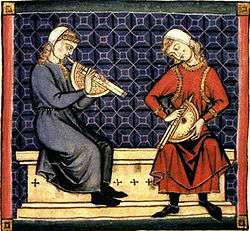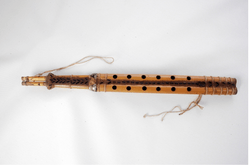Double clarinet
The term double clarinet refers to any of several woodwind instruments consisting of two parallel pipes made of cane, bird bone, or metal, played simultaneously, with a single reed for each. Commonly, there are five or six tone holes in each pipe, or holes in only one pipe while the other acts as a drone, and the reeds are either cut from the body of the instrument or created by inserting smaller, slit tubes into the ends of the pipes. The player typically uses circular breathing.

The double clarinet is not a clarinet in the modern western sense of the term, since it lacks a register key; in this regard it is more closely related to the chalumeau.
Varieties

Double clarinets are found primarily in Middle Eastern music, but also in India;[1] there are different versions and names in different countries. In Yemen, the double clarinet is called a mizmār (a word used for other types of instruments in other countries). More common terms are zamr, zammāra, arghūl, and mijwiz. The first two of these names have the same linguistic root as mizmār.[2]
In Albania the instrument is called a zumare. It has five holes in each pipe, and a bell.[2]
In Egypt the instrument is known as a zummāra. Both tubes are about thirty to thirty-five centimetres long; one may have four to six holes while the other has none and acts as a drone, or both can have holes. Its range is very limited, about a fourth.[2]
The arghūl is primarily an Egyptian instrument, having a melody pipe with five to seven holes and a longer drone pipe without holes. It occurs in several sizes. In one specimen the melody and drone pipes are about 80 and 240 centimetres long, respectively, though the drone has removable sections to alter its pitch.[3]
The Iraqi double clarinet is also called a zummāra, although this term also is used for a single-tube simple clarinet. It is similar to the Syrian mijwiz.[2]
In Morocco and Tunisia the instrument, called zamr, has a single or double bell. The Moroccan instrument has six holes in each pipe. The Moroccan mizmār or zamr rīfī is over 100 centimetres long, again with six holes in each pipe, ending in two bull's horns.[2]
The double clarinet in Syria, western Iraq, Lebanon, northern Israel, and Jordan is called a mijwiz. It is about thirty centimetres long, typically with six holes for each tube. Melodies are played in unison on both pipes, often with one pipe tuned slightly higher than the other to produce acoustic beats.[4]
The Yemeni instrument is called a mizmār. It is attached to the player's mouth using a muzzle.[2]
In Italy, the Sicilian zampogna bagpipe, also called a ciaramedda, is additionally referred to as a "doppio clarinetto" (double clarinet), because of its two equal length single reed chanters. A version of this instrument is also played in the Province of Reggio Calabria. Other single reed, double chanter bagpipes found in Southern Italy include the Sordulina and the zampogna "a moderna", both of which are found in Calabria. In the province of Messina, in the local dialect, the single blade can reed mounted in the instrument's chanters and drones is called a "zammara."
In the island of Ibiza, in the Balearic Islands of Spain, there is the reclam de xeremies. Basque Country has the alboka.
Other meanings
- Double clarinet might refer to an organ stop, also known as the bass clarinet or bass clarionet. ("Double" is here used in the old-fashioned sense of a double-length and hence lower-pitched version of an instrument, e.g. "double bassoon" meaning contrabassoon.)[5]
- Concertos for two clarinets are known as double clarinet concertos.
See also
- Launeddas, a triple clarinet from Sardinia
- Aulochrome, recently invented double soprano saxophone
- Aulos, arguably the ancestor of these instruments
- Argul, a traditional Arabic musical instrument
External links
Notes
- "List A1: Wind Instruments of Regional Cultures Worldwide". Edinburgh University Collection of Historic Musical Instruments. 1999. Archived from the original on 2007-05-26. Retrieved 2007-03-22.
- Pochér, Christian (2001). "Mizmār". In Root, Deane L. (ed.). The New Grove Dictionary of Music and Musicians. Oxford University Press.
- Conner, William J. & Howell, Milfie (2001). "Arghūl". In Root, Deane L. (ed.). The New Grove Dictionary of Music and Musicians. Oxford University Press.
- Pochér, Christian (2001). "Mijwiz". In Root, Deane L. (ed.). The New Grove Dictionary of Music and Musicians. Oxford University Press.
- "Bass Clarinet". Encyclopedia of Organ Stops. 1999. Retrieved 2007-03-22.